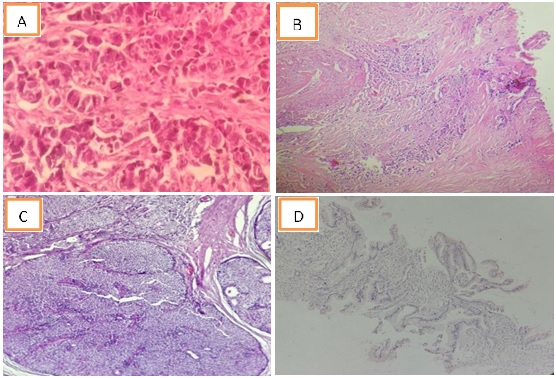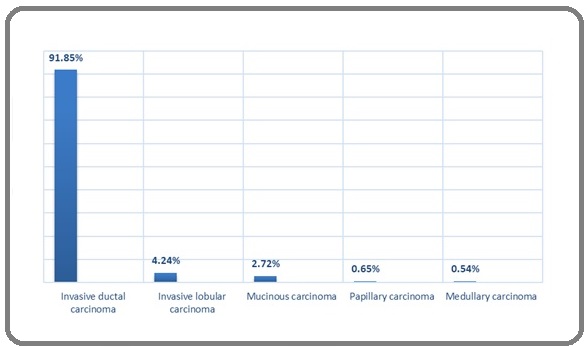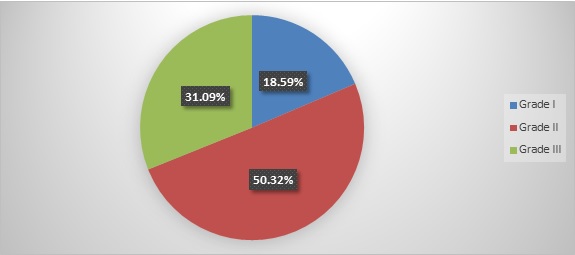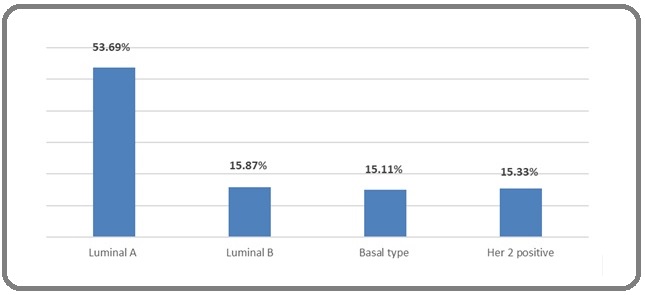Histopathological Patterns and Luminal Subtypes among Breast Cancer Patients in the Middle Euphrates Region of Iraq
Download
Abstract
Objectives: To evaluate the pathological patterns & luminal subtypes of breast cancer patients in the Middle Euphrates region of Iraq.
Methods: A retrospective descriptive study was conducted at Al-Hussein Cancer Center in Karbala province of Iraq between January 2012 and August 2020.
Results: There were 920 female patients with breast cancer. At the time of diagnosis, the mean age was 50.20 ±11.74 years. The most frequent pathological subtype was invasive ductal carcinoma in 91.85%, and 50.32% of tumors were grade II. Of luminal subtypes, Luminal A was the most prevalent subtype in 53.69%.
Conclusion: Our results were similar to middle eastern patterns but significantly differed from western patterns.
Introduction
Worldwide, breast cancer is the most frequently diagnosed tumor and the leading cause of cancer death [1]. In Iraq, it is the most common cancer in females presenting more than 40% of newly diagnosed cancer cases, making breast cancer management a great challenge to health workers in our country [2]. The main risks for developing breast cancer are: age, family history, sedentary lifestyle, early menstruation, late menopause, exposure to radiation, alcoholism, and hormonal replacement therapy [3].
In fact, breast cancer is a heterogeneous complex of diseases, a spectrum of many subtypes with distinct biological features that lead to differences in response patterns to various treatment modalities and clinical outcomes [4]. ER (Estrogen receptors), PR (progesterone receptors) and HER2 (human epidermal growth factor receptors 2) are recognized as major clinical and histopathological prognostic parameters. Based on their express, four major breast cancer luminal subtypes have been identified [5]. These include: Luminal A (ER/PR positive/HER2 negative), Luminal B or Triple Positive (ER/PR positive/HER2 positive), Basal-like or Triple Negative (ER/PR negative/HER2 negative) and HER2- enriched (ER/PR negative/HER2 positive) [4].
Significant geographic variation in luminal subtypes & histopathological pattern has been proved in several studies [6-8]. This study was designed to identify luminal subtypes of breast cancer patients in our region. Then try to compare our results with other researches from nearby middle eastern countries in addition to other developed and developing countries around the world. Our findings will help provide essential knowledge to understand the pathological distribution and establish potential plans for breast cancer management in Iraq.
Materials and Methods
Study design and participants
This retrospective descriptive research was carried out in the Al-Hussein Cancer Center in Karbala province of Iraq on female breast cancer patients diagnosed between January 2012 and August 2020. Our center covers not only Karbala peoples but other patients from the Middle Euphrates area in Iraq who are referred to this center for solid and hematological malignancy management [9]. All patients were diagnosed by tru-cut or excisional biopsy and confirmed by immunohistochemistry markers. Complete information about age, histological subtypes and tumor grades were obtained from the pathological department.
Pathological & immunohistochemical assessment
The studied tissue biopsy specimens of the affected patients were embedded in paraffin and fixed in 10% formaldehyde, then cut and stained with Hematoxylin & Eosin for histopathological examination (Figure 1).
Figure 1. A. Invasive Ductal Carcinoma (400X) B. Invasive Lobular Carcinoma (40X) C. Solid Papillary Carcinoma (100X) D. Invasive Ductal Carcinoma with Mucinous Component (100X).

Following the diagnoses of breast carcinoma, all blocks were assessed regarding the expressions of (ER, PR) and HER2 receptors by semi-quantitative immunohistochemical (IHC) staining technique.
ER and PR contents of the primary tumors were evaluated according to the Allred scoring system, which depends on the percentages of the positive and the staining intensity of tumor cells by using Dako kits ™ (Dako, Denmark), where higher scores indicated the presence and abundance of these receptors. The staining reactions to be considered positive must be reflected in at least 10% of the tumor cells, and the staining intensity was classified as strongly positive (+3), moderately positive (+2) and weak positive (+1) (Figure 2) [10].
Figure 2. A. Diffuse Nuclear Expression of ER Receptors (400X) B. Diffuse Nuclear Expression of PR Receptors (400X) C. Complete Circumferential and Strong Membranous Stain of Her2/neu Receptors (400X).

Labeled streptavidin-biotin (LSAB) method was employed for immunohistochemical detection of HER-2/neu using Hercep Test Kit (K5204 Dako Co.). The intensity of HER-2/neu cell membrane stain was classified into score 0 (negative; no stain is observed or faint membrane staining presents in less than 10% of tumor cells), score 1+ (negative; a faint/barely perceptible membrane staining was detected in more than 10% of tumor cells; these cells exhibit incomplete membrane staining), score 2+ (weakly positive; a weak to moderate complete membrane staining was observed in more than 10% of tumor cells) and score 3+ (strongly positive; a strong complete membrane staining was observed in more than 10% of tumor cells) (Figure 2). Regarding score 2+ (equivocal), the samples were referred to tertiary center in Baghdad city (the capital of Iraq) where CISH (Chromogenic in situ hybridization) analysis was done, which was carried out later on the tissue sections of the same primary tumor. In Iraq, the ZytoDot ® 2C SPEC ERBB2/CEN 17 probe was designed for the simultaneous detection of ERBB2 and centromere 17 in formalin-fixed, paraffin-embedded tissue sections or cell samples [11].
Histologic grading was classified according the Nottingham Grading System which is based on a microscopic evaluation of morphologic and cytologic features of tumor cells, including degree of tubule formation, nuclear pleomorphism, and mitotic count. The sum of these scores stratifies breast tumors into grade 1 (G1; well-differentiated, slow-growing), grade 2 (G2; moderately differentiated), and grade 3 (G3; poorly differentiated, highly proliferative) malignancies [12]. All the results were assessed by two expert pathologists before the final diagnosis.
Analysis of luminal subtypes
According to these parameters four major molecular subtypes are recognized: The luminal A subtype was defined as ER+/HER2- with a KI67 index ≤20% and PR+ with an Allred PR score ≥ 4; the luminal B subtype was defined as an ER+ and/or PR+ tumor, ± HER2+, and with a Ki67 index > 20%, HER2-positive is ER & PR - / HER2 + and Basal-type (triple-negative) is ER, PR and HER2 (negative) [4].
Inclusion / Exclusion criteria
Included in this study were all breast cancer patients diagnosed between January 2012 and August 2020. In addition, any patient with inconclusive results was excluded from the study.
Ethical considerations
Institutional review board (IRB) approval was obtained from the Ethics Committee at Al-Hussein Medical City, Karbala, Iraq.
Statistical analysis
Data of all patients were entered and managed using the Statistical Package for Social Sciences (SPSS) software (version 25). Descriptive statistics of the variables were expressed as number, percentage, median, and range.
Results
There were 920 patients with female breast cancer enrolled in this study. At the time of diagnosis, the mean age was 50.20 ±11.74 years, and the range was (16-97) years. The most frequent histological subtype was invasive ductal carcinoma in 845 patients (91.85%), followed by invasive lobular carcinoma in 39 patients (4.24%), mucinous carcinoma in 25 patients (2.72%), papillary carcinoma in 6 patients (0.65%) and medullary carcinoma in 5 patients (0.54%) as shown in (Figure 3).
Figure 3. Histological Subtypes of 920 Breast Cancer Patients.

Out of the 920 patients, grade II was the most common grade in 463 patients (50.32%), followed by grade III in 286 patients (31.09%) and grade I in 171 patients (18.59%) as shown in (Figure 4).
Figure 4. Histological Grades of Breast Cancer Patients.

Luminal A is classified as the significant subtype among our patients in 494 patients (53.69%), followed by luminal B in 146 patients (15.87%), Her-2 positive in 141 patients (15.33%) and basal type in 139 patients (15.11%) as shown in (Figure 5).
Figure 5. Luminal Subtypes of 920 Breast Cancer Patients.

Discussion
Breast cancer is a complex disease with various subtypes that have different cellular structures, molecular changes, and clinical manifestations. In addition, the prognosis and response to breast cancer treatment depend on multiple variables, including tumor grade & size, lymph node infiltration, ER receptors, PR receptors, and HER-2/neu receptors [13]. In this study, histological pattern and molecular subtype distribution were evaluated in the Middle Euphrates region of Iraq. This is the first large study on breast cancer patients in Karbala province to the best of our knowledge.
Our results showed that the mean age is 50 years. These results are close to those reported in other parts of Iraq (49 years), Saudi Arabia (49 years) and Turkey (51 years), but it significantly younger than the US (59 years) [13-16]. This may be explained because > 58% of the Iraqi population are under 25 years old and only 3.4% are above 65 years [17].
Invasive ductal carcinoma was the most common histological subtype in (91.85%), which is close to prior studies in North Iraq (92.8%), West Iraq (88%), India (95.5%%), Saudi Arabia (88.8%). Still, it is higher than Turkey (78.7%) and the US (75%) [15,18-22].
The second most common histological type was invasive lobular carcinoma, accounting for 4.24% of all cases, which is similar to what has been previously reported in Iraq (3.9%), Saudi Arabia (3%), lower than that of the US (15%) and Turkey (7.8%). Still, it was higher than India, where this histological pattern represents only (1.7%) [15,19,21-23].
On the other hand, mucinous carcinoma represents only (2.72%) similar to the former studies in Iraq (2.1%) and Saudi Arabia (2%) [14,19]. While both papillary carcinoma & medullary carcinoma represent less than (1%) of cases, which is close to results in Saudi Arabia and India, where they represent only (1%) [14,21].
The finding of this study revealed that more than half of our patients' tumors were grade II (50.32%), same results in previous studies in Iraq (67.6%), India (59.5%) and Jordan (48%) [5,21,24].
In our study luminal A subtype was the most common subtype, same results in previous studies in Iraq and the Eastern Mediterranean Region [19,23,25,26]. At the same instant, our results were different than other previous results in Iraq, Indonesia, Vietnam, where luminal B tumors was the predominant subtype [27-29]. Genetics, racial, and environmental factors may be responsible for the disparities & the variations in diagnostic facilities may have a role.
However, the proportion of luminal subtypes varies across the world, luminal A was the commonest molecular subtype in (53.70%) of patients, our results were lower than reported in US (73%) Jordan (60%), Turkey (62%), Saudi Arabia (58.5%) and slightly higher than China (48.6%) and Egypt 41.2% [5,8,15,30].
Luminal B represents (15.87%), that is close to findings in Jordan (13%), Turkey (15%), China (16.7%), Saudi Arabia (14.5%) and Egypt (13.9%) and slightly higher than US (11%) [5,8,15,22,30].
The HER-2/neu subtype was presented about (15.33%) of cases, close to Jordan (12%), Saudi Arabia (12.3%), and Egypt (19.4%) but higher than that of Turkey (8.5%) and US (4%) [5,8,15,22,30,31].
The percentage of triple negative in this study was (15.11%) which is similar to Jordan (15%), Turkey (15%), Saudi Arabia (14.8%), US (12%) and lower than Egypt (28.5%) [5,15,22,30,31].
Our study can be evaluated in terms of its strengths and limitations. A strength of our study is that it can help to provide basic information about breast cancer in Iraq, comparing it to neighboring countries and the world. Moreover, to the best of our knowledge, this study is the first one to be carried out in the Middle Euphrates Region. A limitation of our study is that it covered only the Middle Euphrates Region and not other regions of Iraq.
In conclusion, this study showed that the median age in our patients was a decade younger than in western countries. The most prevalent pathological subtype was invasive ductal carcinoma, and the majority of cases were grade II. In our region, luminal A was the dominant luminal subtype. Future studies in other parts of Iraq with more patients are needed to understand breast cancer dissemination in this country.
References
- Global cancer statistics 2018: GLOBOCAN estimates of incidence and mortality worldwide for 36 cancers in 185 countries Bray F, Ferlay J, Soerjomataram I, Siegel RL , Torre LA , Jemal A. CA: a cancer journal for clinicians.2018;68(6). CrossRef
- Incidence of Hand-Foot Syndrome in Metastatic Breast Cancer Patients Treated with Capecitabine in Middle Euphrates Region of Iraq Mjali A, Hasan ZK . Sci J Med Res.2020;4(16):138-141.
- Association between Female Breast Cancer and Different ABO Blood Groups & Rh Factor in the Sulaymaniyah Province of Iraqi Kurdistan Mjali A, Sheikha A, Amin H, Al-Anssari M, Aljawdah Z, Abbas S. Indian Journal of Public Health Research & Development.2019;10. CrossRef
- Biological subtypes of breast cancer: Prognostic and therapeutic implications Yersal O, Barutca S. World Journal of Clinical Oncology.2014;5(3). CrossRef
- Distribution of breast cancer subtypes among Jordanian women and correlation with histopathological grade: molecular subclassification study Shomaf M, Masad J, Najjar S, Faydi D. JRSM short reports.2013;4(10). CrossRef
- Comparison of Receptor-Defined Breast Cancer Subtypes Between German and Sudanese Women: A Facility-Based Cohort Study Sengal AT , Haj Mukhtar NS , Vetter M, Elhaj AM , Bedri S, Hauptmann S, Thomssen C, Mohamedani AA , Wickenhauser C, Kantelhardt EJ . Journal of Global Oncology.2018;4. CrossRef
- Geographic differences in the distribution of molecular subtypes of breast cancer in Brazil Carvalho FM , Bacchi LM , Pincerato KM , Van de Rijn M, Bacchi CE . BMC women's health.2014;14. CrossRef
- Distinct distribution and prognostic significance of molecular subtypes of breast cancer in Chinese women: a population-based cohort study Su Y, Zheng Y, Zheng W, Gu K, Chen Z, Li G, Cai Q, Lu W, Shu XO . BMC Cancer.2011;11. CrossRef
- Breast Cancer in Middle Euphrates Region of Iraq: Risk Factors, Presenting Symptoms and Time to Medical Help-Seeking Mjali A, Jawad SA , Al-Shammari HHJ . Asian Pacific Journal of Cancer Care.2021;6(3). CrossRef
- The Quantitative ER Immunohistochemical Analysis in Breast Cancer: Detecting the 3 + 0, 4 + 0, and 5 + 0 Allred Score Cases Ilić IR , Stojanović NM , Radulović NS , Živković VV , Randjelović PJ , Petrović AS , Božić M, Ilić RS . Medicina (Kaunas, Lithuania).2019;55(8). CrossRef
- Chromogenic in Situ Hybridization Technique versus Immunohistochemistry in Assessment of HER2/neu Status in 448 Iraqi Patients with Invasive Breast Carcinoma Ali AHM , Yahya AQ , Mohammed HL . Open Access Macedonian Journal of Medical Sciences.2019;7(12). CrossRef
- Genetic reclassification of histologic grade delineates new clinical subtypes of breast cancer Ivshina AV , George J, Senko O, Mow B, Putti TC , Smeds J, Lindahl T, Pawitan Y, Hall P, Nordgren H, Wong JEL , Liu ET , Bergh J, Kuznetsov VA , Miller LD . Cancer Research.2006;66(21). CrossRef
- Molecular classification of breast cancer: A retrospective cohort study Al-Thoubaity FK . Annals of Medicine and Surgery (2012).2020;49. CrossRef
- The incidence, age at diagnosis of breast cancer in the Iraqi Kurdish population and comparison to some other countries of Middle-East and West Molah Karim SA , Ali Ghalib HH , Mohammed SA , Fattah FHR . International Journal of Surgery (London, England).2015;13. CrossRef
- Breast Cancer in Turkey: Clinical and Histopathological Characteristics (Analysis of 13.240 Patients) Özmen V. The Journal of Breast Health.2014;10(2). CrossRef
- Race/Ethnicity, Primary Language, and Income Are Not Demographic Drivers of Mortality in Breast Cancer Patients at a Diverse Safety Net Academic Medical Center Parikh DA , Chudasama R, Agarwal A, Rand A, Qureshi MM , Ngo , Hirsch AE . International Journal of Breast Cancer.2015;2015. CrossRef
- Clinical Outcomes of Patients with Plasma Cell Neoplasm in Sulaymaniyah Province of Iraq Abbas NT , Sheikha A, Mjali A. Systematic Reviews in Pharmacy.2020;11(6).
- A population-based study of Kurdish breast cancer in northern Iraq: Hormone receptor and HER2 status. A comparison with Arabic women and United States SEER data Majid RA , Mohammed HA , Hassan HA , Abdulmahdi WA , Rashid RM , Hughson MD . BMC Women's Health.2012;12(1). CrossRef
- Immunohistochemistry subtypes (ER/PR/HER) of breast cancer: where do we stand in the West of Saudi Arabia? Khabaz MN . Asian Pacific journal of cancer prevention: APJCP.2014;15(19). CrossRef
- Breast Cancer in Western Iraq: Clinicopathological Single Institution Study Al-Esawi A. Advances in Breast Cancer Research.2016;05. CrossRef
- Evaluation of clinico: pathologic findings of breast carcinoma in a general hospital in Southern India Mohapatra M., Satyanarayana S.. Indian Journal of Cancer.2013;50(4). CrossRef
- American Cancer Society. Breast Cancer Facts & Figures 2019-2020. 2020 [ cited in June 2020] Available from : https://www.cancer.org/content/dam/cancer-org/research/cancer-facts-and-statistics/breast-cancer-facts-and-figures/breast-cancer-facts-and-figures-2019-2020.pdf ..
- Breast Cancer Subtypes among Iraqi Patients: Identified by Their ER PR and HER2 Status Muallah FH , Tawfeeq FN , Alwan NA . J Fac Med Baghdad.2017;59(4):303-307.
- Tumor Characteristics of Female Breast Cancer: Pathological Review of Mastectomy Specimens Belonging to Iraqi Patients Alwan N. Journal of Breast Cancer.2018.
- Defining breast cancer prognosis based on molecular phenotypes: results from a large cohort study Dawood S, Hu R, Homes MD , Collins LC , Schnitt SJ , Connolly J, Colditz GA , Tamimi RM . Breast Cancer Research and Treatment.2011;126(1). CrossRef
- First report on molecular breast cancer subtypes and their clinico-pathological characteristics in Eastern Morocco: series of 2260 cases Elidrissi Errahhali M, Elidrissi Errahhali M, Ouarzane M, El Harroudi T, Afqir S, Bellaoui M. BMC women's health.2017;17(1). CrossRef
- Breast cancer in Iraq is associated with a unimodally distributed predominance of luminal type B over luminal type A surrogates from young to old age Majid RA , Hassan HA , Muhealdeen DN , Mohammed HA , Hughson MD . BMC women's health.2017;17(1). CrossRef
- Pattern of Presentation of Patients With Breast Cancer in Iraq in 2018: A Cross-Sectional Study Mutar MT , Goyani MS , Had AM , Mahmood AS . Journal of Global Oncology.2019;5. CrossRef
- Luminal B is the Most Common Intrinsic Molecular Subtypes of Invasive Ductal Breast Carcinoma Patients in East Kalimantan, Indonesia Paramita S, Raharjo EN , Niasari M, Azizah F, Hanifah NA . Asian Pacific journal of cancer prevention: APJCP.2019;20(8). CrossRef
- Molecular subtypes of breast carcinoma in Saudi Arabia. A retrospective study Alnegheimish NA , Alshatwi RA , Alhefdhi RM , Arafah MM , AlRikabi AC , Husain S. Saudi Medical Journal.2016;37(5). CrossRef
- Molecular subtypes of breast carcinoma in Egyptian women: clinicopathological features El-Hawary AK , Abbas AS , Elsayed AA , Zalata KR . Pathology, Research and Practice.2012;208(7). CrossRef
License

This work is licensed under a Creative Commons Attribution-NonCommercial 4.0 International License.
Copyright
© Asian Pacific Journal of Cancer Biology , 2022
Author Details